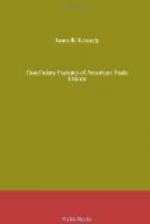The secretary-treasurer in the majority of the unions is the chief official concerned in administering the benefits. Such is the case in the Typographical Union, the Brotherhood of Painters, the United Association of Plumbers, the Boot and Shoe Workers’ Union, the Tobacco Workers’ Union, the Brotherhood of Leather Workers on Horse Goods, and the Barbers’ International Union.[211] In the Iron Molders’ Union, the Brotherhood of Carpenters, the Wood Workers’ Union, the Glass Bottle Blowers’ Association, the United Garment Workers’ Union, and the Granite Cutters’ Union these duties are divided between the general secretary and the general treasurer.
[Footnote 211: Typographical Union, Constitution, 1904 (Indianapolis, n.d.), p. 26; Plumbers’ Constitution, 1904 (Chicago, n.d.), pp. 19-21; Painters’ Constitution, 1904 (La Fayette, n.d.), secs. 230-241; Boot and Shoe Workers’ Constitution, 1904 (Boston, n.d.), sec. 7; Tobacco Workers’ Constitution, 1900, third edition, 1905 (Louisville, n.d.), pp. 10-15; Leather Workers on Horse Goods, Constitution, 1904 (Kansas City, n.d.), p. 7; Barbers’ Constitution, 1905 (Indianapolis, n.d.), pp. 13-14.]
Ordinarily no particular part of the funds of the union is devoted to the payment of beneficiary claims. The unions paying insurance, however, are exceptional in this respect. In such cases the funds of the insurance departments are separate from the general funds of the brotherhoods, and the dues for maintaining the insurance departments are levied as assessments distinct from the general levies. Nearly all the grand lodges have made provision in their constitutions against encroachments upon the beneficiary funds by the grand officers for the benefit of other departments. The Trainmen and the Switchmen provide that the beneficiary fund shall be used exclusively in paying death and disability claims.[212] The Telegraphers provide that no part of the mortuary fund shall be paid out, loaned or diverted for any purpose except for the payment of approved death claims.[213] The Firemen pay out of their beneficiary fund “all expenses for the proper conducting of the beneficiary departments."[214] The position of the Conductors on this point is not so explicit. The Order, however, holds in reserve a fund of $300,000, from which the grand officers may draw, in case the assessments levied for beneficiary purposes are insufficient to pay legal claims and the surplus in the beneficiary fund is not sufficient to cover the deficit.[215] The Engineers and the Maintenance-of-Way Employees have no specific regulation of this kind; but the implication is that similar protection is furnished their funds. The Letter Carriers provide that the beneficiary fund shall be used exclusively for paying insurance claims.
[Footnote 212: Constitution of the Railroad Trainmen, 1903 (Cleveland, 1903), sec. 58; Constitution of the Switchmen’s Union of North America. 1903 (Buffalo, n.d.), sec. 57.]




